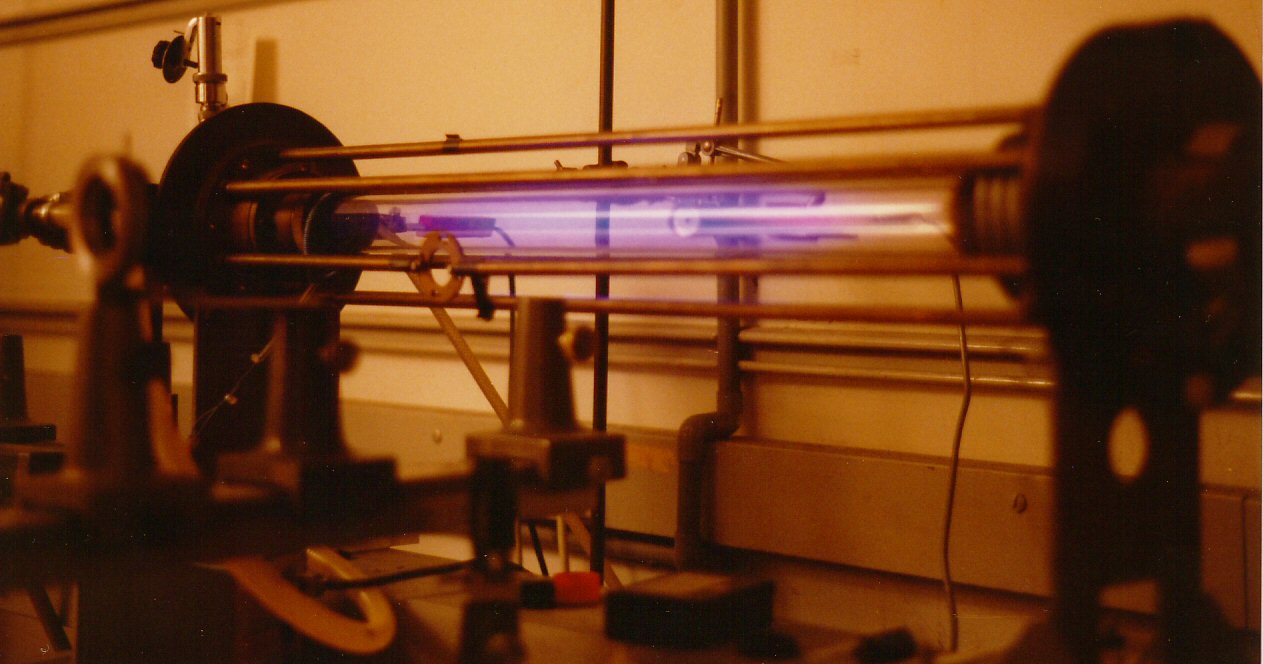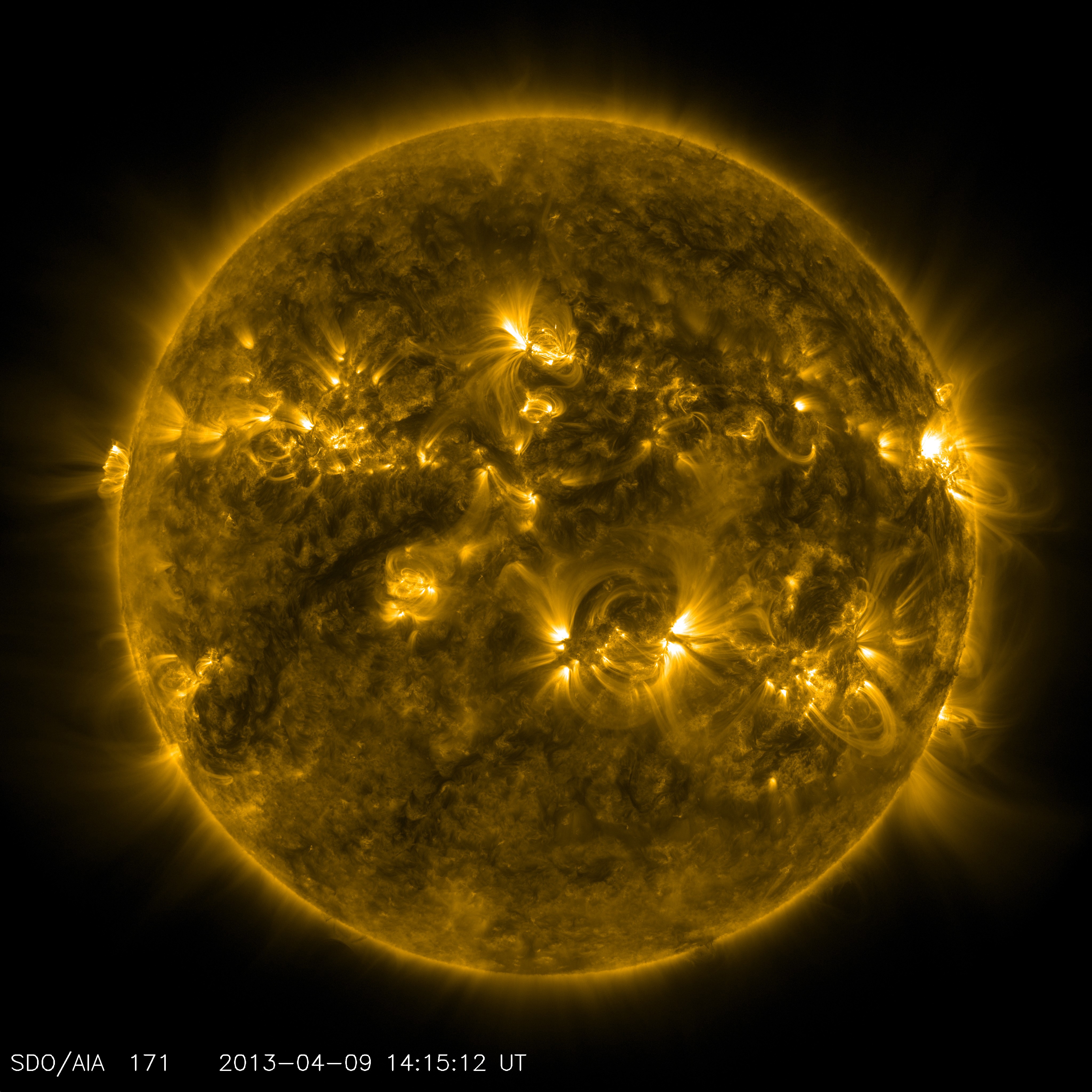|
Kink Instability
A kink instability (also kink oscillation or kink mode), is a current-driven plasma instability characterized by transverse displacements of a plasma column's cross-section from its center of mass without any change in the characteristics of the plasma. It typically develops in a thin plasma column carrying a strong axial current which exceeds the Kruskal–Shafranov limit and is sometimes known as the Kruskal–Shafranov (kink) instability. The kink instability was first widely explored in fusion power machines with Z-pinch configurations in the 1950s. It is one of the common magnetohydrodynamic Magnetohydrodynamics (MHD; also called magneto-fluid dynamics or hydromagnetics) is the study of the magnetic properties and behaviour of electrically conducting fluids. Examples of such magnetofluids include plasmas, liquid metals, ... instability modes which can develop in a pinch plasma and is sometimes referred to as the m=1 mode. (The other is the m=0 mode known as ... [...More Info...] [...Related Items...] OR: [Wikipedia] [Google] [Baidu] |
Kink Instability At Aldermaston
Kink or KINK may refer to: Common uses * Kink (sexuality), a colloquial term for non-normative sexual behavior * Kink, a curvature, bend, or twist Geography * Kink, Iran, a village in Iran * The Kink, a man-made geographic feature in remote eastern Alaska Arts, entertainment, and media * ''Kink'' (film), a documentary about the internet pornography company Kink.com * ''Kink'', an autobiography written by Dave Davies, guitarist for the Kinks * Kink.com, a BDSM-focused Internet pornography company * The Kinks, a British rock band * ''The Kink'' (novel), a 1927 detective novel by Lynn Brock Radio and television * ''KinK'', a Canadian documentary television series profiling some of the more unusual edges of human sexuality * KINK and kink.fm, a radio station in Portland, Oregon, United States * Kink FM, a radio station in the Netherlands People named Kink * Dick Kink (1921–1971), American politician * KiNK (Strahil Velchev), a music producer and DJ in Sofia, Bulgaria * Ge ... [...More Info...] [...Related Items...] OR: [Wikipedia] [Google] [Baidu] |
Electric Current
An electric current is a stream of charged particles, such as electrons or ions, moving through an electrical conductor or space. It is measured as the net rate of flow of electric charge through a surface or into a control volume. The moving particles are called charge carriers, which may be one of several types of particles, depending on the conductor. In electric circuits the charge carriers are often electrons moving through a wire. In semiconductors they can be electrons or holes. In an electrolyte the charge carriers are ions, while in plasma, an ionized gas, they are ions and electrons. The SI unit of electric current is the ampere, or ''amp'', which is the flow of electric charge across a surface at the rate of one coulomb per second. The ampere (symbol: A) is an SI base unit. Electric current is measured using a device called an ammeter. Electric currents create magnetic fields, which are used in motors, generators, inductors, and transformers. In ... [...More Info...] [...Related Items...] OR: [Wikipedia] [Google] [Baidu] |
Plasma Stability
The stability of a plasma is an important consideration in the study of plasma physics. When a system containing a plasma is at equilibrium, it is possible for certain parts of the plasma to be disturbed by small perturbative forces acting on it. The stability of the system determines if the perturbations will grow, oscillate, or be damped out. In many cases, a plasma can be treated as a fluid and its stability analyzed with magnetohydrodynamics (MHD). MHD theory is the simplest representation of a plasma, so MHD stability is a necessity for stable devices to be used for nuclear fusion, specifically magnetic fusion energy. There are, however, other types of instabilities, such as velocity-space instabilities in magnetic mirrors and systems with beams. There are also rare cases of systems, e.g. the field-reversed configuration, predicted by MHD to be unstable, but which are observed to be stable, probably due to kinetic effects. Plasma instabilities Plasma instabilities can be ... [...More Info...] [...Related Items...] OR: [Wikipedia] [Google] [Baidu] |
Center Of Mass
In physics, the center of mass of a distribution of mass in space (sometimes referred to as the balance point) is the unique point where the weighted relative position of the distributed mass sums to zero. This is the point to which a force may be applied to cause a linear acceleration without an angular acceleration. Calculations in mechanics are often simplified when formulated with respect to the center of mass. It is a hypothetical point where the entire mass of an object may be assumed to be concentrated to visualise its motion. In other words, the center of mass is the particle equivalent of a given object for application of Newton's laws of motion. In the case of a single rigid body, the center of mass is fixed in relation to the body, and if the body has uniform density, it will be located at the centroid. The center of mass may be located outside the physical body, as is sometimes the case for hollow or open-shaped objects, such as a horseshoe. In the case of a ... [...More Info...] [...Related Items...] OR: [Wikipedia] [Google] [Baidu] |
Plasma (physics)
Plasma ()πλάσμα , Henry George Liddell, Robert Scott, ''A Greek English Lexicon'', on Perseus is one of the four fundamental states of matter. It contains a significant portion of charged particles – ions and/or s. The presence of these charged particles is what primarily sets plasma apart from the other fundamental states of matter. It is the most abundant form of ordi ... [...More Info...] [...Related Items...] OR: [Wikipedia] [Google] [Baidu] |
Kruskal-Shafranov Limit
In a toroidal fusion power reactor, the magnetic fields confining the plasma are formed in a helical shape, winding around the interior of the reactor. The safety factor, labeled q or q(r), is the ratio of the times a particular magnetic field line travels around a toroidal confinement area's "long way" (toroidally) to the "short way" (poloidally). The term "safety" refers to the resulting stability of the plasma; plasmas that rotate around the torus poloidally about the same number of times as toroidally are inherently less susceptible to certain instabilities. The term is most commonly used when referring to tokamak devices. Although the same considerations apply in stellarators, by convention the inverse value is used, the rotational transform, or i. The concept was first developed by Martin David Kruskal and Vitaly Shafranov, who noticed that the plasma in pinch effect reactors would be stable if q was larger than 1. Macroscopically, this implies that the wavelength of the p ... [...More Info...] [...Related Items...] OR: [Wikipedia] [Google] [Baidu] |
Fusion Power
Fusion power is a proposed form of power generation that would generate electricity by using heat from nuclear fusion reactions. In a fusion process, two lighter atomic nuclei combine to form a heavier nucleus, while releasing energy. Devices designed to harness this energy are known as fusion reactors. Research into fusion reactors began in the 1940s, but as of 2022, only one design, an inertial confinement laser-driven fusion machine at the US National Ignition Facility, has conclusively produced a positive fusion energy gain factor, i.e. more power output than input. Fusion processes require fuel and a confined environment with sufficient temperature, pressure, and confinement time to create a plasma in which fusion can occur. The combination of these figures that results in a power-producing system is known as the Lawson criterion. In stars, the most common fuel is hydrogen, and gravity provides extremely long confinement times that reach the conditions needed for fusion e ... [...More Info...] [...Related Items...] OR: [Wikipedia] [Google] [Baidu] |
Z-pinch
In fusion power research, the Z-pinch (zeta pinch) is a type of plasma confinement system that uses an electric current in the plasma to generate a magnetic field that compresses it (see pinch). These systems were originally referred to simply as pinch or Bennett pinch (after Willard Harrison Bennett), but the introduction of the θ-pinch (theta pinch) concept led to the need for clearer, more precise terminology. The name refers to the direction of the current in the devices, the Z-axis on a normal three-dimensional graph. Any machine that causes a pinch effect due to current running in that direction is correctly referred to as a Z-pinch system, and this encompasses a wide variety of devices used for an equally wide variety of purposes. Early uses focused on fusion research in donut-shaped tubes with the Z-axis running down the inside the tube, while modern devices are generally cylindrical and used to generate high-intensity x-ray sources for the study of nuclear weapons ... [...More Info...] [...Related Items...] OR: [Wikipedia] [Google] [Baidu] |
Magnetohydrodynamics
Magnetohydrodynamics (MHD; also called magneto-fluid dynamics or hydromagnetics) is the study of the magnetic properties and behaviour of electrically conducting fluids. Examples of such magnetofluids include plasmas, liquid metals, salt water, and electrolytes. The word ''magnetohydrodynamics'' is derived from ' meaning magnetic field, ' meaning water, and ' meaning movement. The field of MHD was initiated by Hannes Alfvén, for which he received the Nobel Prize in Physics in 1970. The fundamental concept behind MHD is that magnetic fields can induce currents in a moving conductive fluid, which in turn polarizes the fluid and reciprocally changes the magnetic field itself. The set of equations that describe MHD are a combination of the Navier–Stokes equations of fluid dynamics and Maxwell’s equations of electromagnetism. These differential equations must be solved simultaneously, either analytically or numerically. History The first record ... [...More Info...] [...Related Items...] OR: [Wikipedia] [Google] [Baidu] |
Sausage Instability
A sausage is a type of meat product usually made from ground meat—often pork, beef, or poultry—along with salt, spices and other flavourings. Other ingredients, such as grains or breadcrumbs may be included as fillers or extenders. When used as an adjective, the word ''sausage'' can refer to the loose sausage meat, which can be formed into patties or stuffed into a skin. When referred to as "a sausage", the product is usually cylindrical and encased in a skin. Typically, a sausage is formed in a casing traditionally made from intestine, but sometimes from synthetic materials. Sausages that are sold raw are cooked in many ways, including pan-frying, broiling and barbecuing. Some sausages are cooked during processing, and the casing may then be removed. Sausage-making is a traditional food preservation technique. Sausages may be preserved by curing, drying (often in association with fermentation or culturing, which can contribute to preservation), smoking, or ... [...More Info...] [...Related Items...] OR: [Wikipedia] [Google] [Baidu] |
Magnetic Force
In physics (specifically in electromagnetism) the Lorentz force (or electromagnetic force) is the combination of electric and magnetic force on a point charge due to electromagnetic fields. A particle of charge moving with a velocity in an electric field and a magnetic field experiences a force of \mathbf = q\,\mathbf + q\,\mathbf \times \mathbf (in SI unitsIn SI units, is measured in teslas (symbol: T). In Gaussian-cgs units, is measured in gauss (symbol: G). See e.g. )The -field is measured in amperes per metre (A/m) in SI units, and in oersteds (Oe) in cgs units. ). It says that the electromagnetic force on a charge is a combination of a force in the direction of the electric field proportional to the magnitude of the field and the quantity of charge, and a force at right angles to the magnetic field and the velocity of the charge, proportional to the magnitude of the field, the charge, and the velocity. Variations on this basic formula describe the magnetic fo ... [...More Info...] [...Related Items...] OR: [Wikipedia] [Google] [Baidu] |







